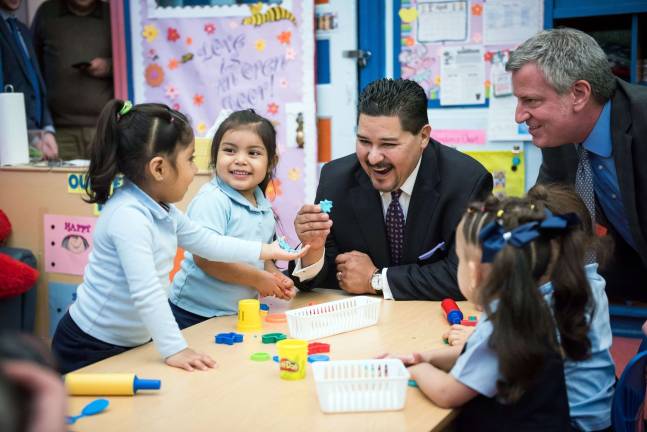pedagogical passion play

PERSPECTIVE
Or how city, state and federal policies, politics and polemics — for better or worse — are impacting the state of our schools and the lives of our school kids
BY DOUGLAS FEIDEN
It has been a consequential and controversial year in the classrooms of New York and the educational battlefields of Albany and Washington.
Consider the reign of Donald Trump and the bumpy track record of Betsy DeVos, his disputatious secretary of education.
On her first official visit to the city, DeVos opted to tour two Orthodox Jewish schools, including the Manhattan School for Girls on East 70th Street – and was lambasted for visiting a total of zero public schools.
Unmistakably, if not very subtly, the administration was signaling its backing for public funding for religious schools, vouchers for private schools and enhanced school choices for alternates like charter schools.
Then examine the gubernatorial contest pitting Andrew Cuomo, once a rare pro-charter New York pol, against Cynthia Nixon, who has turned equitable school funding into the mantra of her campaign.
The challenger has already succeeded in one respect: Dragging Cuomo to the left. He’s backtracked on school choice and educational reform, and cozied up to the powerful teachers unions he once vowed to tame.
Out on the hustings, at least thus far, Nixon’s signature issue has failed to translate into political momentum.
But by blasting Cuomo for “blocking fair funding of public schools” — and demanding sky-high taxes to “reverse chronic underfunding” — she’s put the too-little-cash-for-our-kids formulation on the map in a big way, increasing the likelihood that more monies will flow into the system under the next governor.
For his part, Cuomo has sought to defang any political liability. School funding has shot up significantly on his watch, to $26.5 billion in the current fiscal year from the $20.5 billion school budget he inherited when he first took office in 2011, he often points out on the stump.
Meanwhile, Bill de Blasio’s reelection last year — and the exit in April this year of Carmen Fariña, his first-term chancellor — paved the way for a new push by the mayor to shake up the municipal school system, the world’s largest.
His defining accomplishment to date had been the kickoff in September 2015 of free, universal, full-day, pre-kindergarten for all 4-year-olds. Now, he was determined to build on that legacy by making the schools more diverse — and opening up the city’s eight specialized high schools to more students from disadvantaged backgrounds.
But first came a spectacular fiasco: His first pick for chancellor, Alberto Carvalho, the superintendent of schools in Miami-Dade County, turned down the job on live television, a day after accepting it, and opted to remain in Florida.
It was hugely embarrassing. Barely 24 hours earlier, de Blasio had called him the “best person to lead the nation’s biggest school system into the future.” It would have been humorous, too — except that the chancellor oversees 1.1 million students, 75,000 teachers, 1,800-plus schools and a budget of roughly $25 billion.
So the mayor turned to his No. 2 choice, Richard Carranza, grandson of Mexican immigrants and the son of a hairdresser and a sheet-metal worker. After a mere three weeks on the job, the new chancellor on April 27 plunged into a racial minefield.
A plan to bolster school diversity in the Upper West Side’s District 3 — by earmarking 25 percent of seats for sixth-grade students assessed at lower proficiency levels on English and math exams — had been assailed by parents who argued it would result in students with higher test scores being shut out of their preferred schools.
They spoke up at a contentious meeting, about overhauling the middle-school admissions process to boost diversity, at P.S. 199 on West 70th Street. It was captured in a video that aired on NY1. And shortly after, Carranza tweeted an article about the event that characterized the dynamics in stark racial terms.
“WATCH: Wealthy white Manhattan parents angrily rant against plan to bring more black kids to their schools,” he tweeted, linking to a piece on the site Raw Story that had run under the same headline.
Carranza later backed away from the tweet. But he didn’t back away from the fray. Or the administration’s pro-diversity pitch. “Let’s stop talking about a tweet, and start talking about the issue,” he said a few days later. “And the issue is segregated schools.”
For some people, segregation may conjure up bulldogs and fire hoses and racist violence to keep blacks out of the schools of the Deep South in the 1960s. For others, it accurately conveys the de facto separation of the races in public education through legal if abhorrent means that must be reversed by governmental policy.
It is that latter definition that the de Blasio administration embraces. The goal is to open doors for black and Hispanic students in the schoolhouses where they’ve historically been underrepresented. And absent any more gaffes from Carranza, that is the policy that City Hall has been forcibly advocating ever since.
Bottom line: Every single twist and turn of educational politics, policies and polemics at the city, state and federal levels ultimately impacts the schools and school children of New York City.
invreporter@strausnews.com